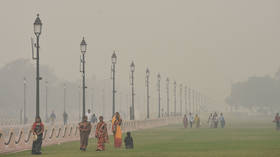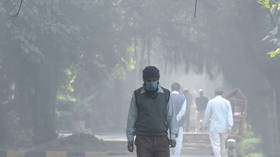New Delhi residents lose 12 years of life due to poor air quality – study

A new study by the University of Chicago ahead of the G20 summit in New Delhi shows that the Indian capital is the most-polluted megacity in the world, with levels 25 times above WHO guidelines. The research warns that residents’ lives may be cut short by 12 years due to poor air quality.
The report, titled ‘AQLI 2023’, identifies India as the country facing “the greatest health burden” as a result of air pollution due to the large number of people affected by its high particulate pollution concentrations.
In India’s Northern Plains, the average resident is “on track” to lose around eight years of their life expectancy if pollution levels persist, the study warns. This region, which is home to around half-a-billion people, includes the states of Bihar, Chandigarh, Haryana, Punjab, Uttar Pradesh and West Bengal, as well as several union territories, including Delhi.
The main threat to citizens’ health, the report explained, comes from the particulate pollution concentrations in India, which has accounted for 59.1% of the spike in pollution across the world since 2013. According to new and revised 2021 satellite-derived data, pollution in India increased by a significant amount between 2020 and 2021. The situation is grave in New Delhi, which has an annual average particulate pollution more than 25 times higher than guidelines set out by the World Health Organization (WHO).
On average, the study found, residents of the heavily polluted South Asian countries of Bangladesh, Nepal, India and Pakistan will lose about five years of their lives due to pollution. In contrast, Americans will lose just 3.6 months of their lives as a result of poor air quality, it added.
The increase in air pollution in South Asia can be attributed to “industrialization, economic development, and population growth” over the past two decades. The report also cited an increase in traffic as a significant contributing factor, as the number of vehicles on Indian roads has quadrupled since the early 2000s. In Delhi, the burning of farm stubble in neighboring states during the Diwali festival (October-November) and industrial emissions are also seen as major causes.
The report also stated that very few countries in Asia and Africa have “air quality standards” despite the fact that the world’s two largest continents “contribute 92.7% of life years lost due to pollution.” It further warned that “without concerted policy action, the threat of air pollution will also grow.”
New Delhi has frequently been listed as the world’s most polluted capital city in recent years. The Indian government has responded to the issue by introducing a range of programs aimed at reducing pollution levels. In 2019, the Modi government initiated the National Clean Air Program (NCAP), seeking to reduce 2017 particulate pollution levels by between 20% and 30% by 2024. The program was revamped in 2022, with the aim of reducing particulate pollution levels by 40% by 2026 across 131 cities, at least 38 of which are in the heavily polluted Northern Plains region.
Data released by India’s Ministry of Environment, Forest, and Climate Change on May 23 shows that the particulate matter concentration in Delhi rose during the 2021-22 fiscal year. However, the government has been able to achieve success in other major cities such as Mumbai, which in the same period witnessed an improvement of 34% compared to 2017-18. In a bid to curb pollution, the Indian government has tightened vehicle emission norms, introduced metro rails, developed more expressways, and boosted the adoption of electronic vehicles.













